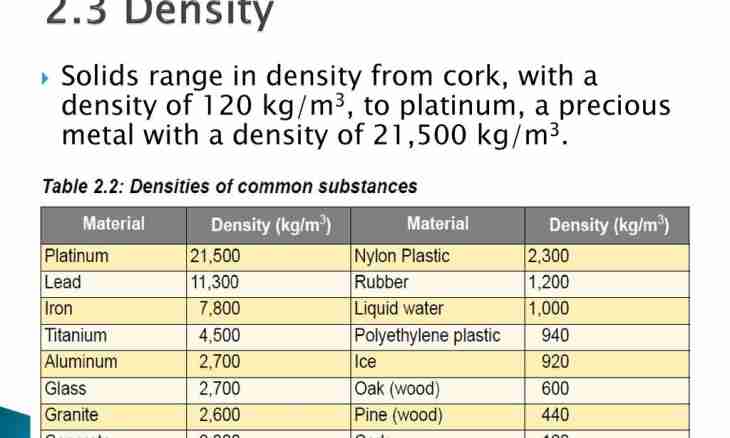Density of material shows how many it weighs when occupies a certain volume. Calculation of density - one of the first investigation phases. Knowing a reference indicator, it is possible to define availability of impurity, emptiness, etc. At the same time it is necessary to distinguish true, average and bulk density. It is especially important in construction where the vast majority of materials have porous structure.
It is required to you
- - scales;
- - tools for measurement of volume;
- - the material samples having the correct geometrical form;
- - table of density;
- - calculator.
Instruction
1. Decide what density you need to determine. It can be true, average or bulk. True density - size for this material a constant. It represents a certain standard to which other indicators are compared. Determination of true density requires substance of which material, but without time and emptiness consists. Samples of such substances are usually stored in laboratories of quality control at the enterprises. Their density is calculated under the conditions determined by state standards, first of all it is temperature and humidity.
2. Make experiment by determination of average density of substance. For school or house experience it is the best of all to take a subject from material rather dense and not especially subject to external influences. Determine its volume. The subject of the correct form (for example, a metal cube) can just be measured. For measurement of volume of other small objects take a volumetric glass, pour a number water there and notice its volume. Put a subject in a glass and look at what level there is a water surface now. Subtract the first from the second indicator. It will also be the volume of your object. At you it turned out objemometr, similar to those which are used also in some laboratories. Transfer milliliters to cubic centimeters.
3. Weigh a subject. For a school experiment the accuracy which pharmaceutical or laboratory scales give suffices. Divide the received weight into volume. It will also be density of material of which an object is made.
4. In construction and industrial laboratories the samples for determination of average density are usually specially prepared. They are dried up at a temperature established by standards, the Humidity very strongly influences density. To a bowl of all materials represent porous structures. In a usual state in a time there is an air. At the increased humidity of emptiness are filled with water. It is heavier than air, material weighs more, and respectively, also its density increases. For example, construction materials warm up for drying at a temperature 105-110ºС. The error when weighing should not exceed 0.1 g for weight less than 0.5 kg and 1 g - for samples with a bigger weight.
5. In certain cases use a method of hydrostatic weighing. It is similar on that which you used for determination of density in laboratory. The sample is dried up at first and weighed, then saturated with water, erase moisture from a surface and again weigh a sample. After that it is immersed in glass with water.
6. The indicator "the bulk density" is applied to the materials having granular or powdery structure. It considers the mass of substance together with emptiness in this volume. Calculate bulk density just as any other, that is having divided weight into volume. The humidity is defined by state standards, and for each bulk it is the.

